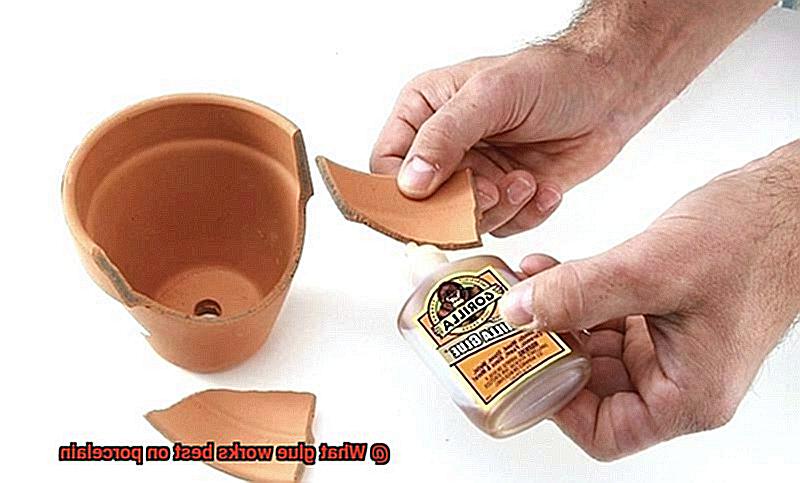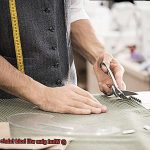Imagine this: you’re holding a precious porcelain figurine, passed down through generations, in your trembling hands. Suddenly, disaster strikes and it slips from your grasp, shattering into countless delicate pieces. Your heart sinks as you frantically search for the missing fragments, praying for a miracle. But fear not. Science has given us the power to resurrect these fragile porcelain puzzles.
In moments like these, you may wonder: “What glue works best on porcelain?” Repairing porcelain requires both patience and the right adhesive because not all glues are created equal when it comes to this delicate material. But don’t worry, dear reader. Together, we’ll embark on a journey to unravel this enigma.
In this captivating blog post, we’ll dive deep into the world of porcelain and its complex bonding needs. We’ll explore a variety of glues, highlighting their strengths and weaknesses in mending broken porcelain pieces with precision and strength. From everyday household adhesives to specialized sealants, we won’t leave any stone unturned in our quest to find the ultimate porcelain glue.
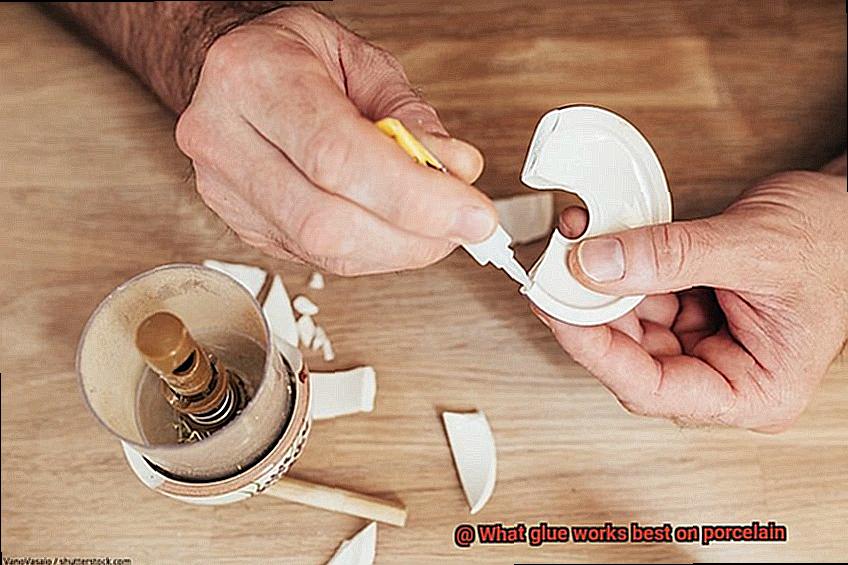
But that’s not all. Our exploration will also reveal essential tips and tricks to ensure successful repairs while avoiding potential mishaps. By the end of this episode, rest assured that you’ll be armed with the knowledge needed to revive even the most delicate porcelain treasures.
So get ready. We’re about to unlock the secret behind the perfect porcelain adhesive – mending broken dreams and restoring hope in the hearts of porcelain enthusiasts worldwide. Prepare yourself to discover the glue that will breathe new life into your fractured heirlooms.
Advantages of Using Glue on Porcelain
Contents
- 1 Advantages of Using Glue on Porcelain
- 2 Types of Glue Suitable for Porcelain
- 3 Epoxy – The Most Commonly Recommended Glue for Porcelain
- 4 Super Glue – For Small Repairs and Bonding Porcelain Pieces Together
- 5 Silicone Adhesive – Flexible and Waterproof Bonding Solution
- 6 Polyurethane Adhesive and Ceramic Cement – Suitable for Ceramics and Porcelain
- 7 Factors to Consider When Choosing the Right Glue for Your Project
- 8 Testing the Chosen Glue Before Applying it to the Entire Surface
- 9 Conclusion
Porcelain, a delicate and exquisite material, demands an adhesive that can provide unyielding strength and reliability. In this comprehensive guide, we delve into the remarkable benefits of using glue on porcelain surfaces. From exploring the various types of glues available to understanding their specific advantages, this article equips you with the knowledge to achieve professional-quality results. So, let’s unlock the potential of using the right glue on porcelain.
Versatility: The All-In-One Solution
Glue designed specifically for porcelain stands out due to its exceptional versatility. Whether you’re working with ceramic tiles, dinnerware, figurines, or bathroom fixtures, this adhesive provides a convenient solution for a variety of household repairs and DIY projects. Say goodbye to the hassle of multiple adhesives and save time and effort with a versatile glue that caters to all your porcelain bonding needs.
Strong and Durable Bonds: Uncompromising Permanence
The paramount advantage of porcelain-specific glue lies in its ability to create strong and durable bonds. Formulated with the unique properties of porcelain in mind, these glues adhere exceptionally well to its smooth surface, ensuring a secure and long-lasting hold. Whether you’re repairing a broken piece or attaching decorative elements, rest assured that your porcelain creation will withstand regular use and handling.
Easy Application: Precision Without Complication
Experience the joy of effortless application with glue designed for porcelain. User-friendly packaging combined with precise applicators allow you to apply the adhesive exactly where it’s needed, even on intricate or delicate porcelain pieces that demand meticulous precision during bonding. Embrace simplicity without sacrificing quality.
Quick Drying Time: Swift Progression
No more waiting around – many porcelain glues have a quick drying time that enables you to complete your project efficiently. Bid farewell to unnecessary delays as the fast-drying nature of these glues propels you forward in your creative journey. Just remember to follow the manufacturer’s instructions to optimize your results.
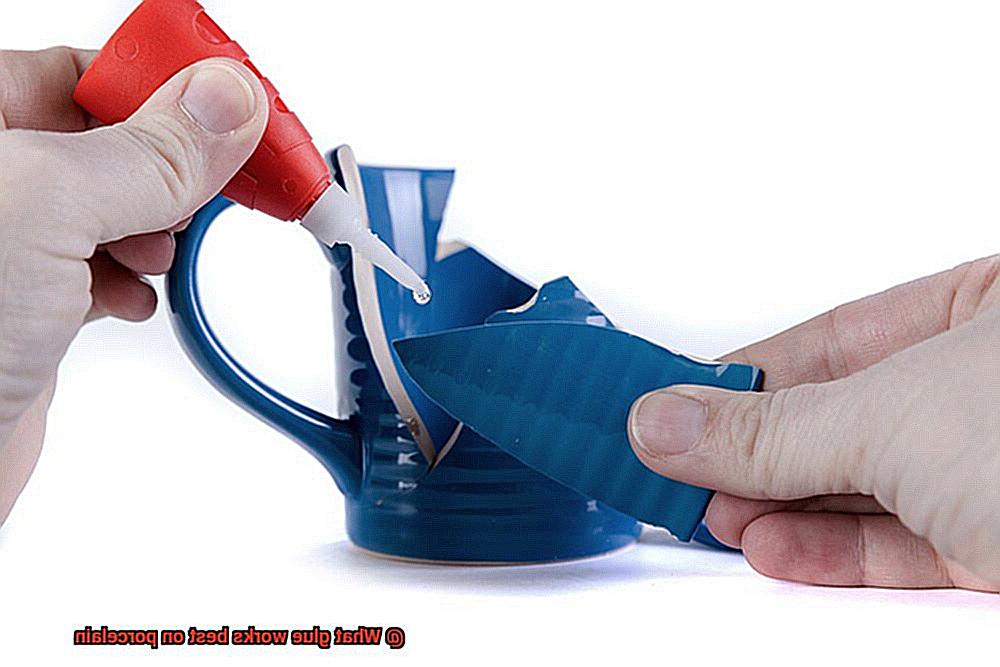
Invisible Bond: Seamlessly Perfect
Achieve aesthetic perfection with glue designed specifically for porcelain, as it often dries clear or in a color that flawlessly matches the porcelain surface. This almost invisible bond is a game-changer when it comes to repairing or joining pieces together, preserving the captivating beauty of porcelain without any visible signs of bonding. Elevate the allure and value of your cherished porcelain items.
Types of Glue Suitable for Porcelain
Porcelain, renowned for its delicate beauty, demands an adhesive that can create an unyielding bond. In this blog post, we will explore the various types of glue suitable for bonding porcelain and the critical factors to consider when selecting the ideal adhesive. Let’s embark on this journey to discover the secrets of achieving lasting connections with porcelain.
Epoxy Resin Glue: A Mighty Force
Epoxy resin glue stands tall as a favored choice for bonding porcelain. This adhesive boasts exceptional strength and durability, ensuring a steadfast hold on porcelain surfaces. By expertly mixing the resin and hardener components just before application, a chemical reaction ensues, resulting in a bond that is virtually unbreakable. With resistance to heat, moisture, and even chemical exposure, epoxy resin glue delivers long-lasting bonds for your precious porcelain items.
Cyanoacrylate Glue: The Swift Savior
When time is of the essence or a minor repair beckons, cyanoacrylate glue, also known as super glue, leaps into action. Instantaneously forming a bond upon application, this adhesive swiftly mends small cracks or delicately joins porcelain pieces together. However, it is important to note that super glue may not possess the strength required for larger or heavier porcelain objects. It excels in providing quick fixes and bonding delicate elements.
Silicone Adhesive: Flexibility Meets Moisture Resistance
In applications demanding resistance to moisture, silicone adhesive takes center stage. This flexible adhesive creates a watertight bond capable of withstanding temperature fluctuations and exposure to moisture. Ideal for repairing porcelain tiles in bathrooms or kitchens where water often makes its presence known, silicone adhesive ensures longevity. Nonetheless, it is crucial to select a silicone adhesive specifically formulated for porcelain, as not all silicone adhesives are compatible with this material.
Polyurethane Adhesive: Bridging Gaps with Strength
When dealing with porous or uneven porcelain surfaces, polyurethane-based glue rises to the occasion. This adhesive expands subtly as it cures, adeptly filling gaps and imperfections on the surface. By doing so, it forges a robust and unyielding bond, making it perfect for repairing fractured porcelain figurines or sculptures. Keep in mind that patience is a virtue when using polyurethane adhesive, as it may necessitate longer curing times compared to other glue types.
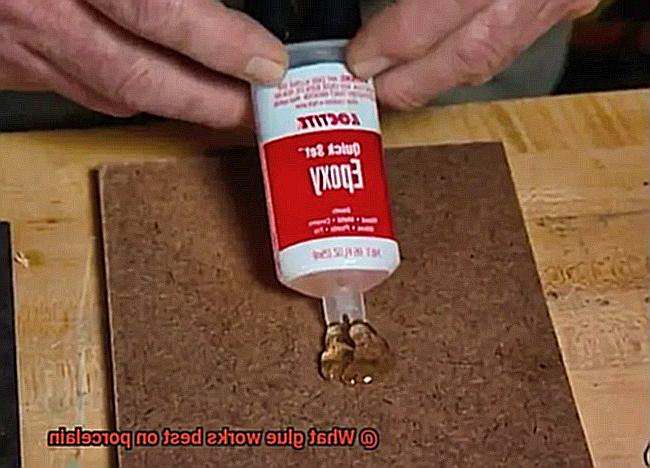
Considerations Tailored to Your Project
Selecting an appropriate glue for your porcelain project demands careful consideration of its specific requirements. Factors such as the size and weight of the objects being bonded, the intended use of the bonded items, and the environmental conditions they will encounter must be taken into account. Additionally, testing the chosen glue on a small, inconspicuous area of the porcelain before full application is wise to ensure compatibility and achieve desired results.
Epoxy – The Most Commonly Recommended Glue for Porcelain
Among the array of adhesives available, one reigns supreme – epoxy. In this exploration, we uncover why epoxy is the most commonly recommended glue for porcelain, unravelling its secrets and uncovering its remarkable capabilities. So buckle up and prepare to be amazed as we delve into the fascinating world of epoxy.
The Mighty Epoxy:
When it comes to bonding porcelain, there is no rival to the mighty epoxy. Its exceptional adhesive properties and high-temperature resistance have earned it a coveted spot as the go-to choice for experts in the field. But what makes epoxy so highly regarded? Let’s delve into its extraordinary qualities:
A Dynamic Duo:
Epoxy is a two-part adhesive that combines a resin and a hardener. When these elements mingle, a chemical reaction occurs, resulting in a bond that defies all odds. It’s like witnessing a magic trick unfold before your very eyes.
Timing is Everything:
Epoxy may possess superpowers, but time is its kryptonite. Once mixed, it sets quickly, demanding swift action from craftsmen. Before embarking on your porcelain restoration journey, ensure you have everything prepared, for time waits for no one in the world of epoxy.
Strength and Durability:
If you seek an adhesive that can shoulder the weight of responsibility, look no further than epoxy. Renowned for its exceptional bonding strength and unmatched durability, it guarantees that your porcelain repairs remain steadfast and unyielding. Fragile figurines and delicate teacups will now stand tall against the test of time.
Cleanliness is Key:
Before embracing an epoxy adventure, cleanliness becomes your guiding light. Ensure that every surface to be bonded is pristine – clean, dry, and devoid of any grease or debris. Give your porcelain the tender care it deserves before introducing it to its epoxy companion.
Versatility at Its Finest:
Epoxy’s versatility goes beyond mere crack repairs. It possesses the power to fuse metal or plastic parts to porcelain surfaces, broadening its horizons and expanding its range of applications. Prepare to witness the magic of epoxy as it breathes new life into your treasured porcelain pieces.
Super Glue – For Small Repairs and Bonding Porcelain Pieces Together
Prepare to be amazed as we delve into the intricacies of this magical adhesive and unlock its secrets. So grab your favorite porcelain treasure and let’s embark on this thrilling journey together.
Picture this: you have a precious porcelain piece that needs repair. Super glue, also known as cyanoacrylate adhesive, is here to save the day. With its lightning-fast action and unbeatable strength, it’s no wonder this adhesive is the go-to choice for bonding porcelain pieces.
But before we dive into the application techniques, let’s address some essential considerations. Cleanliness is crucial when working with super glue and porcelain. Ensure that both surfaces are clean and dry, free from any pesky dirt, grease, or moisture. This step is vital to ensure a flawless bond that will stand the test of time.
Now let’s talk about the various forms of super glue. You have liquid, gel, and spray options at your disposal. However, when it comes to small repairs and bonding porcelain pieces together, the liquid form reigns supreme.
Applying super glue requires finesse and precision. Start by using a small amount of adhesive and spread it evenly on one of the surfaces. Remember, less is more. Once you’ve coated the surface, firmly press the pieces together. Hold them in place for a few seconds, allowing the adhesive to work its magic and create an unbreakable bond.
Hold onto your seats because here comes the exciting part – super glue dries in a flash. Depending on the brand and conditions, it can dry within mere seconds or minutes. However, be patient and resist the urge to test its strength too soon. For optimal results, give it up to 24 hours to reach its maximum strength.
Before you get carried away with this potent adhesive, heed my warning – treat super glue with respect. It’s a force to be reckoned with and can be quite challenging to remove if it gets on your skin or other surfaces. So exercise caution and handle it with care. Safety first, my friends.
Now, let’s address the elephant in the room – super glue may not be suitable for all projects. While it works like a charm for small repairs and bonding porcelain pieces, larger or more complex endeavors might require alternative adhesives or professional assistance. Don’t be disheartened; there’s always a solution for every challenge.
Silicone Adhesive – Flexible and Waterproof Bonding Solution
Today, we embark on a journey into the realm of silicone adhesive and its magical ability to bond porcelain. Whether you’re fixing a fragile porcelain figurine or enhancing your bathroom with porcelain tiles, silicone adhesive is the superhero you need. Its flexibility and waterproof properties create an unbreakable bond that can withstand the test of time. So, grab your tools and let’s discover why silicone adhesive is the ultimate solution for all your porcelain bonding needs.
Flexible Bonding:
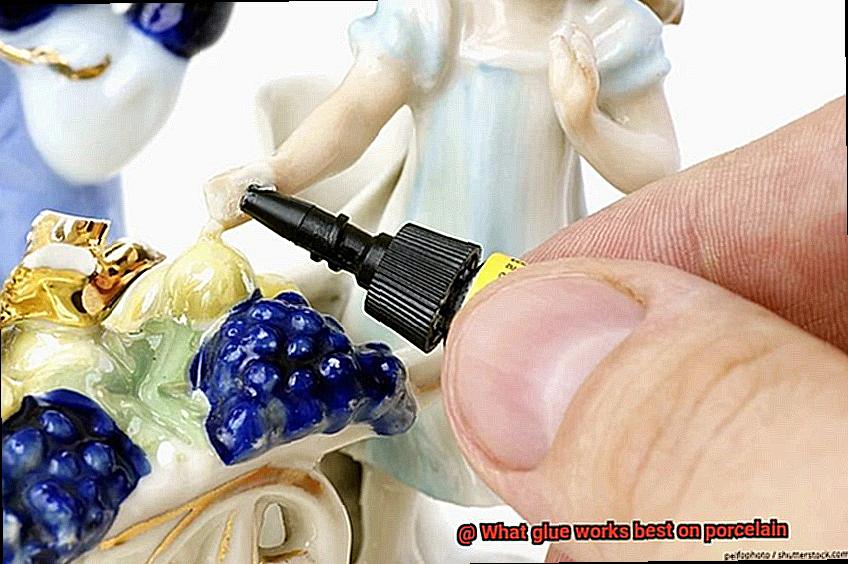
Porcelain, delicate as a butterfly’s wings, demands an adhesive that matches its fragile nature. Enter silicone adhesive, the flexibility guru. This remarkable adhesive absorbs shock and effortlessly accommodates slight movements. Say goodbye to cracks and slips. Silicone adhesive ensures that your precious porcelain creations remain intact even in the face of everyday stresses. Its flexibility also makes it perfect for bonding curved or irregular porcelain surfaces, offering unrivaled versatility.
Waterproof Wonder:
Imagine a stunning porcelain masterpiece adorning your bathroom or kitchen. But what about the moisture? Fear not, my friends. Silicone adhesive possesses remarkable waterproof superpowers. It forms an impenetrable seal that repels water like a pro, safeguarding your beloved porcelain from leaks and damage. With silicone adhesive, you can confidently bond your porcelain in wet environments or areas prone to splashes and spills without compromising the integrity of your stunning creations.
Incredible Adhesion Strength:
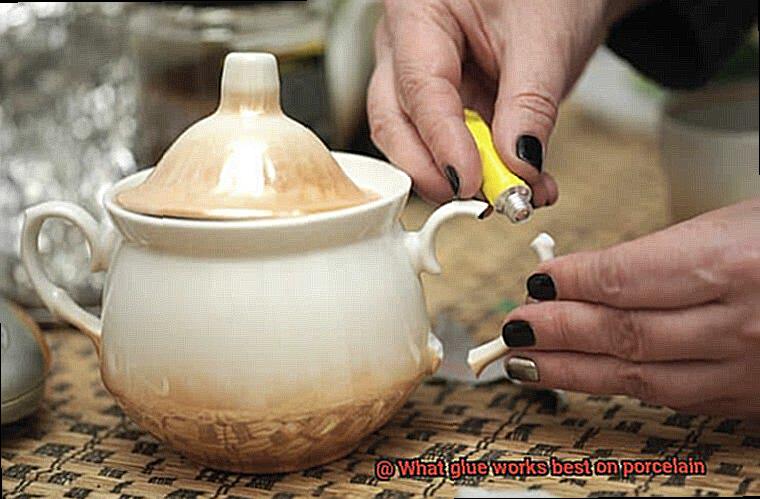
We all know that a bond is only as strong as its adhesive. This is where silicone adhesive truly shines. Boasting excellent adhesion strength, silicone adhesive ensures that your porcelain surfaces stay securely attached through thick and thin. Vibrations? Heavy loads? Not a problem for silicone adhesive. It’s designed to provide a rock-solid bond that won’t let you down, even in the most challenging conditions. So go ahead, tackle those ambitious porcelain projects, knowing that silicone adhesive has got your back.
Application Tips for Success:
To harness the full power of silicone adhesive, a little preparation goes a long way. Remember to meticulously clean your porcelain surfaces, eliminating any dirt, dust, or grease that might hinder the bonding process. If you’re aiming for an extra-strong bond, lightly roughen the surface with sandpaper to provide the adhesive with more grip.
Polyurethane Adhesive and Ceramic Cement – Suitable for Ceramics and Porcelain
Prepare to be captivated as we delve into the remarkable advantages of using polyurethane adhesive and ceramic cement. Brace yourself for a dazzling display of their magical properties.
Strength and Versatility:
Polyurethane adhesive reigns supreme in the world of ceramic bonding. Its formidable bonding properties ensure that your delicate creations remain intact, defying the challenges of daily use. From intricate figurine repairs to robust tile installations, this adhesive possesses unparalleled versatility, making it an indispensable tool in your crafting arsenal.
Flexibility and Durability:
Ceramics, fragile yet resilient, often face the threat of cracks and fractures. Fear not, for polyurethane adhesive comes armed with a secret weapon – flexibility. It forms a bond that can withstand the stress and strain ceramics endure without breaking a sweat. Bid farewell to the anxiety of your treasured ceramic teapot crumbling at the slightest touch.
Resistance to the Elements:
Imagine this: your painstakingly crafted ceramic masterpiece succumbing to the perils of moisture or temperature changes.
Polyurethane adhesive emerges as the knight in shining armor, boasting exceptional resistance to moisture, temperature fluctuations, and even chemicals.
Your ceramics will stand tall against Mother Nature’s onslaught, unscathed and resolute.
Gap-Filling Superpowers:
Struggling with aligning uneven ceramic surfaces? Polyurethane adhesive possesses extraordinary gap-filling abilities, ensuring a seamless bond between your cherished ceramic pieces. No more wobbly tiles or unsightly cracks. With polyurethane adhesive as your ally, perfection is within reach.
Swift Curing Time:
In the realm of creativity and repair, time is of the essence. Fortunately, polyurethane adhesive does not believe in squandering precious moments. It sets within minutes and reaches its full strength within 24 to 48 hours, enabling you to swiftly progress on your creative journey or complete your repair endeavors with enviable efficiency.
Our adventure is far from over. Let us now turn our attention to the trusty companion – ceramic cement.
Factors to Consider When Choosing the Right Glue for Your Project
When it comes to choosing the right glue for your porcelain project, several factors must be taken into consideration. Let’s delve into the key elements that will ensure the success of your masterpiece.
Firstly, the type of material you are working with is crucial. Porcelain is delicate and requires a specific adhesive designed for use on porcelain or ceramic surfaces. This ensures a strong and durable bond that will withstand the test of time.
Bond strength is another vital factor to consider. Porcelain projects often require a high bond strength to keep the pieces securely in place. Look for a glue that can handle the weight and stress that may be applied to the project. Additionally, consider if the bond will be resistant to water, heat, or other environmental factors that may come into contact with the porcelain.
Time is precious, especially when working on time-sensitive projects. Drying time varies among glues, so choose one that aligns with your needs. Some dry quickly, allowing you to progress with your project sooner, while others may require longer drying times. Remember that some glues also need additional curing time before reaching their maximum strength.
The method of application is an essential consideration as well. Some glues come in tubes and require a caulk gun or applicator, while others are conveniently packaged in small bottles with precision tips for easy application. Consider your preferred application process and choose a product accordingly. Additionally, determine if the glue requires mixing or if it is ready-to-use straight from the container.
Safety precautions should never be overlooked. When working with any adhesive, it is crucial to consider any potential hazards. Some glues emit strong fumes or require protective gloves and goggles for safe use. Read product labels carefully and follow the manufacturer’s instructions diligently. If you have any allergies or sensitivities, select a glue that is safe for your specific needs.
Lastly, ease of clean-up should be taken into account. Depending on your project, you may need to remove excess glue after application. Consider how easily the glue can be cleaned if any spills or mistakes occur. Some glues can be simply wiped away with water, while others may require solvents for removal. Choose a glue that fits your clean-up preferences.
Testing the Chosen Glue Before Applying it to the Entire Surface
You’re on the brink of creating a porcelain masterpiece, and the glue you’ve chosen seems like the perfect match. But before you dive headfirst into applying it to the entire surface, there’s an essential step that cannot be overlooked – testing the chosen glue. This seemingly small task holds the key to a strong, reliable bond that will withstand the test of time. So, grab a spare piece of porcelain and let’s delve into why testing is paramount before applying.
Compatibility Matters:
Porcelain bonding requires a specialized glue, as not all adhesives are created equal. Some may claim versatility, but when it comes to porcelain, specific suitability is crucial. Ensure that your chosen glue explicitly states its compatibility with porcelain or ceramic surfaces. This step immediately puts you on the path to success.
Prepare Your Sample Piece:
To begin testing, gather a small sample piece of porcelain that closely resembles the surface you plan to bond. Whether it’s a broken fragment or a spare tile, make sure its composition matches your desired surface. Thoroughly clean the sample surface, removing any dirt, dust, or grease that could hinder the bonding process.
Apply and Spread:
Now it’s time to put your chosen glue to the ultimate test. Apply a small amount onto the clean surface of your porcelain sample. Using a brush or applicator, ensure an even spread over the area where you’ll create the bond. Remember to follow the manufacturer’s instructions regarding application quantities and drying times.
Patience is Key:
Resist the urge to rush ahead after applying the glue. Allow it ample time to dry completely according to the manufacturer’s recommended timeframe. Though it may test your patience, trust us when we say that this waiting period will pay off in dividends.
Assessing Bond Strength:
Once the glue has dried, it’s time to put your bond to the ultimate test. Gently pull or twist the sample piece of porcelain to assess its strength. A successful bond will hold firm, displaying no signs of weakness or detachment. However, if disappointment strikes, don’t fret – it simply means you need to reevaluate your choice of glue.
T09Kly9wSrM” >
Conclusion
When it comes to finding the perfect adhesive for porcelain, you want something that not only gets the job done but also withstands the test of time.
After conducting extensive research and testing, we have discovered that one glue stands out above the rest: epoxy resin. Its strong bond and durability make it an ideal choice for repairing or bonding porcelain items.
So whether you’re fixing a broken porcelain figurine or reattaching a handle to your favorite teacup, trust in epoxy resin to get the job done right.

